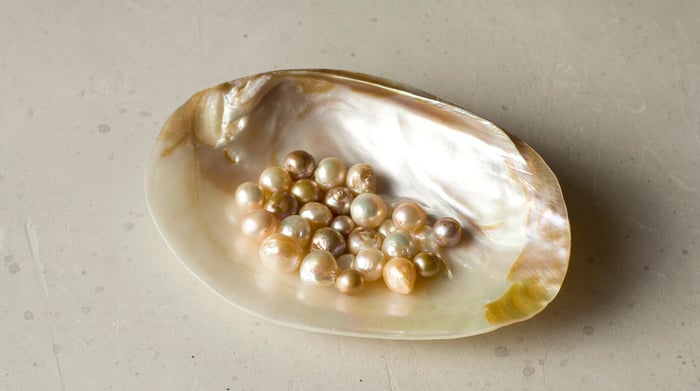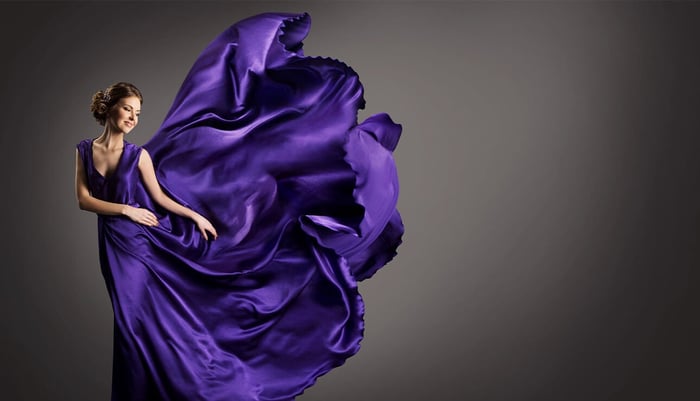If there is one accessories trend that people can’t seem to get enough of at the moment, it's pearls. From the runways to Paris Fashion Week to the pages of Vogue all the way to your Instagram feed, what was once seen as something only your gran could pull off is currently dominating the airwaves with no signs of slowing down. Whether sported rather daringly with a casual tee and pair of relaxed jeans or adorned with an elegant cocktail dress in heels, people are really making this pearl trend their own by mastering it in some very creative ways.
But with so many brands jumping on the pearl bandwagon, it can be hard to draw a line between what is real and what is fake. Especially as many shoppers will turn to charity op shops and vintage stores to find their pearls in an attempt to be more sustainable and to stay within their budget. This can make knowing how to tell if pearls are real somewhat difficult as the shape and colour of pearls can make them very easy to emulate. Fortunately, there are a handful of tell-tale signs that you can use to figure out whether your pearl jewellery is authentic or not without having to call into your local jewellery store or by investing in costly specialised equipment.
Read on for handy tips and tricks on how to tell if pearls are real or not, and to find out more interesting facts about this seriously on-trend gemstone.

Overview:
How Are Pearls Made?
Before learning how to tell if pearls are real or not, it is worthwhile knowing how pearls are made, as not only can it be helpful when figuring out if a particular stone is authentic or not, but it's also just a fascinating process. While most people in the jewellery world consider pearls to be a member of the gemstone family and it is even recognised as the June birthstone, the origins of pearls are vastly different to their other gem counterparts. Pearls are the only gemstone known to us that isn’t mined on land. In fact, it doesn’t even form in the ground. Pearls are created inside the shells of marine oysters and freshwater mussels as well as fossil Conulariida. One of the very few gemstones produced organically, a pearl is formed when the organism releases nacre or ‘mother of pearl’, a composite made of aragonite, which is a mineral, and conchiolin-a type of protein. Over time, the layers of this liquid-like deposit begin to harden into a spherical shape with a shiny lustre that resembles what we’ve come to know and love as pearls today.

Pearls are essentially a defence mechanism for a mollusc, which will release the protein and mineral-rich substance as the result of irritants such as a grain of sand, bacteria, food or even a piece of its mantle becoming trapped in the shell. When the oyster or mussel secretes nacre, it will essentially trap the irritant within it by depositing it on there and growing around it. While more traditional pieces such as pearl necklaces and bracelets will have a rich porcelain colour and a relatively small, spherical shape, pearls come in many different shapes, colours and sizes. Some pearls have a higher lustre than others because of how the aragonite is arranged during their formation, while others will have a completely different coloured hue depending on what type of mollusc it was formed in. Not all pearls are naturally occurring, in fact, natural pearls are coming increasingly rarer. As a result, most pearls are produced with the intervention of humans on oyster farms. This is done by placing a small piece of glass, a shell or a mantle in the mollusc and waiting for it to form. The pearls that originate this way are called cultured pearls and they are the most common type of pearls out there. In order to get cultured pearls, a farmer will essentially raise the mollusc and keep it healthy for around three years until they are mature enough to implant. Once they are ready, the far will implant them with the graft and nucleus and harvest the pearls 18 months to three years later.
What Are The Different Types of Pearls Out There
When attempting to decipher whether your pearls are authentic or not, it's also important to be mindful of the fact that not all pearls are created equal. Something that will come as a surprise to a lot of people is that there are at least eight different variations of pearls and not all of them are formed in the same way. Some are naturally occurring, others are cultured and then there are some which are completely man-made. Not to mention, there are some which only occur in freshwater while others are exclusively found in the ocean. So, what are the different types of pearls out there?

Whether you’re shopping for that perfect pair of pearl earrings or browsing for pearl engagement rings even, the most common types of pearls you are likely to come across are freshwater pearls, South Sea pearls, Keshi pearls, Mabe pearls, Tahitian pearls, Kasuminga pearls, Akoya pearls and simulant pearls-which you will likely have to be the most conscious of. Particularly, when learning how to tell if pearls are real or not.
How To Tell If Pearls Are Real
It’s always exciting when you come across the perfect forever piece to add to your permanent jewellery collection, particularly if you have been looking for a long time. However, there is also no worse than getting duped, especially when you are putting some serious cash into something. Unfortunately, when there are so many places to shop, you cannot always be certain that what you are buying is the real deal. Whether you bought your accessories online, at the mall, a small boutique, or a charity store, getting your money’s worth is important. So, here is how to tell if pearls are real without having to consult a professional.

Look For Visual Clues
The first way to check whether your pearls are real or not is to keep an eye out for visual clues. One of the more telling clues that a pearl is real is its lustre. Lustre is what jewellers use to describe the type of light that is reflected off of diamond and gemstone jewellery, including pearls. Most good-quality pearls will have a bright, clear and shiny lustre when placed under a light. They are so shiny and bright, in fact, that if you look closely you should be able to see your own reflection. Simunlant pearls, on the other hand, have a relatively dull lustre that almost feels like dry chalk.

Another key element that could be used to tell if your pearls are real is the overtone of the stones. Pearls are highly prized for their overtones, a.k.a the subtle colours present on the surface of each stone. This is something that is so subtle that is incredibly hard to replicate. As a result, often faux pearls will appear as though they have too much colour. If your pearls are set onto a bracelet, pendant or necklace, chances are they will have a drill hole which can be another telling sign whether your pearls are authentic or not. Using a magnifying glass or jewellery eyelet, you can inspect the hole for characteristics present in both authentic and inauthentic pearls such as the edges of the hole which are normally sharp on real pearls and well-rounded or rough on simulant pearls. Inside the hole, real pearls will usually have a distinct line that separates the out nacre layer from the nucleus, whereas, fake pearls do not and will occasionally also have chipped paint or coating around the hole.
Use Your Teeth
Jewellery enthusiasts have used the tooth test for decades attempting to tell if their pearls are real or not. The belief is that if you gently bite down on the pearl or slowly rub them against your teeth you should be able to tell if they are authentic. Many believe this hack to be relatively foolproof, as most authentic pearls have a slightly rough or gritty texture due to the nacre. On the contrary, simulant pearls are relatively smooth due to being made out of either glass or hard plastic. To try the tooth test for yourself, simply take your pearls and softly bite down on them using the tips of your two front teeth.

If you aren’t game enough to try this method, you can also place them between your thumb and forefinger before gently rubbing them against your teeth in a side-to-side motion. If the pearls feel slightly rough and gritty against your teeth they are likely real due to the scale-like imperfections that occur when the nacre forms. If the pearl feels perfectly smooth and effortlessly glides over your teeth, though, it is likely to be inauthentic as simulant pearls rarely have imperfections. When trying out the tooth trick, try to be as gentle as possible as you don’t want to damage your other pearly whites or cause any discomfort. You should also ensure that your teeth are clean or recently brushed when trying out this trick as you do not want to hinder your efforts with food and other items that get stuck in your teeth.
Rub Two Pearls Together
If you own multiple pearls or an item adorned with more than one pearl such as a pair of pearl earrings or a strand of pearls, you may want to try rubbing two pearls together to check their authenticity. Due to the multiple layers of nacre present, real pearls are never really smooth, this means that if you were to hold two pearls between your fingers and gently rub them together it would create a little bit of friction. This is because the slightly gritty edges of a pearl catch on one another when rubbed together

If you were to do the same thing with two simulant pearls, however, you would find that they effortlessly glide past each other due to their incredibly smooth surface which often contains a thin, shiny coating. Another telltale sign that your pearls are real that can arise from this hack is the appearance of a powdery white residue on your hands. While pearls are somewhat durable, rubbing them against another pearl can cause the outer layers to erode slightly-resulting in the appearance of powered nacre. If you do attempt this trick to find out whether your pearls are real or not, ensure that you handle them with care and do not rub them together too hard as this can potentially damage the outer layer of your pearls or affect their shape slightly.
Weigh Them
Another big indicator of a pearl’s authenticity is weight. Whether it's diamonds or gemstones, the heavier stone is usually the real deal and pearls are no exception. Despite their size, pearls are surprisingly heavy. In the case of cultured pearls, this is partly due to the size of the nucleus, however, the many layers of hardened nacre can also play a role in the stone’s weighted appearance. Contrastingly, simulated pearls will feel relatively light in your hand due to being made out of nothing but a small piece of plastic or glass with a thin coating.

So, if you happen to have a loose pearl that you are one hundred per cent certain of its authenticity and another which you aren’t, hold them in the palms of your hands for a few seconds and see whether you will feel a difference. While it can vary depending on their size, a real pearl is likely to feel a lot heavier in your hand (almost like a small marble). Simulant pearls, on the other hand, are very light to the point where they feel weightless, much like a bead. And while weighing pearls is not necessarily a foolproof way to test the authenticity of your jewellery, it does provide you with the means to identify potentially faux pearls when shopping and makes you attuned to the characteristics of an authentic pearl.
Check Their Temperature
If you have multiple pearls in your jewellery box, another handy and cost-effective hack to test their authenticity is the temperature hack. If you own a lot of gemstone necklaces, you will notice that they feel surprisingly cool when you place them on your skin after not wearing them for a long time, almost to the point that they may give you goosebumps or make the hairs on your neck stand up on end. The same goes for natural and cultured pearls, but not simulant pearls. Given that they are almost always made out of plastic or glass, simulant pearls heat up rather quickly and will often feel like they are at room temperature. So, if the pearls are real you should feel a real difference in temperature between them and your naturally warm hands.

If you have multiple pearls at home, place them in your hands like you would if you were testing their weight. If you feel a cool sensation similar to the one you feel when picking out a coin from your wallet or stepping onto a tiled floor with bare feet, it is likely your pearls are authentic. Keep in mind that if you do try out the temperature test that you are not trying it with a piece that you have worn recently as they are likely to feel warmer due to your body heat.
9ct Yellow Gold Shell and Freshwater Pearl Pendant on Chain of Length 46cm
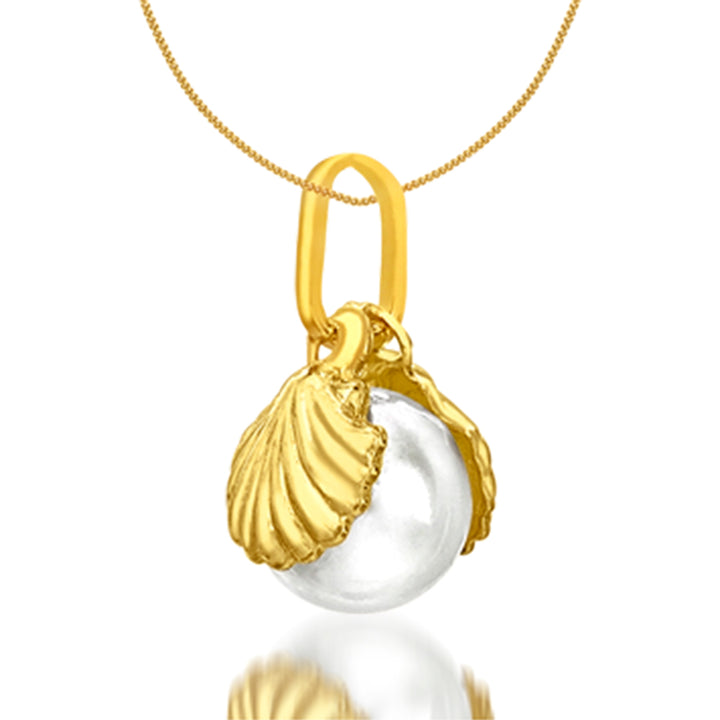
$71.99
9ct Yellow Gold Shell and Freshwater Pearl Pendant on Chain of Length 46cm… read more
Sterling Silver Freshwater Pearl Drop Earrings
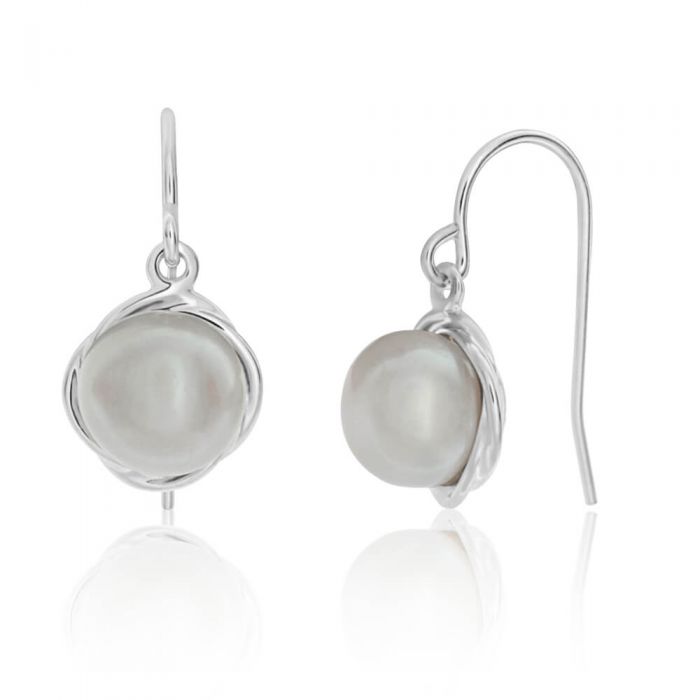
$29.99
These Sterling Silver Freshwater Pearl Drop Earrings are the perfect size to accent any outfit. The design is feminine and graceful, while the simple shape of the earrings makes this pair easy to pair with other jewellery pieces. Add a… read more
9ct White Gold Tahitian Pearl & Diamond Drop Earrings
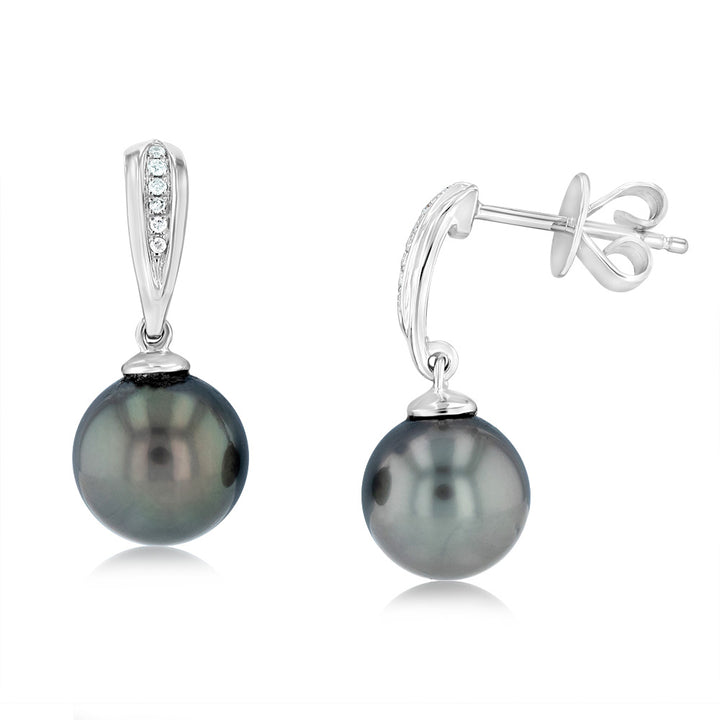
$349.00
These stunning 9ct White Gold Drop Earrings with black Tahitian Pearl & Diamond are the perfect combination of timeless elegance and contemporary design. Designed with both beauty and durability in mind, they are the perfect formal accessory that you can… read more
You May Also Like:
- A Guide To The Different Types Of Earrings
- What Are Argyle Diamonds? All You Need To Know
- Everything You Need to Know About Floating Diamond Necklaces
- How To Wear Earrings With Sensitive Ears: An Introduction To Hypoallergenic Earrings
- What Is Morganite & Other Morganite FAQs
- Men’s Necklace Styles & How To Wear Them


.png)
